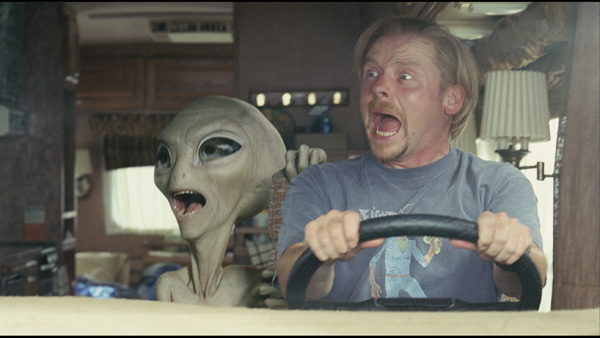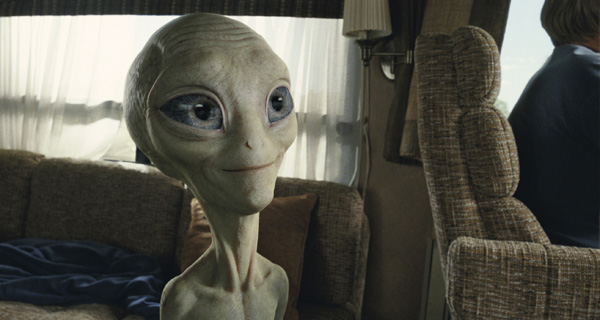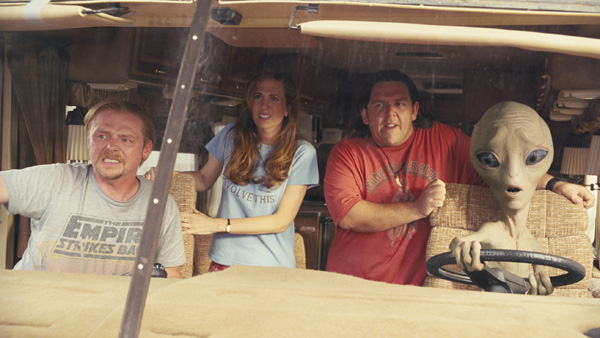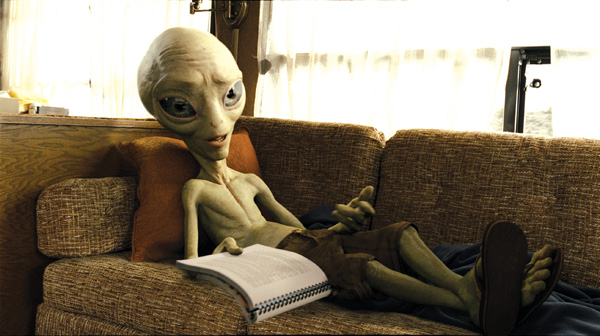| Even the production - director Greg Mottola and producers Nira Park and Eric Fellner – first described Paul in terms of what they did NOT want him to be – not cartoony, exotic or extreme. Animation Supervisor Anders Beer and VFX Supervisor Jody Johnson began working and carrying out tests at Double Negative on Paul’s character as far back as 2007. He needed to be a familiar, grounded, photorealistic ‘grey’ alien of a type the audience would recognize from generations of science fiction movies and video games, with a big head, large dark eyes and spindly little body.
One of the Guys
In fact, among the references Double Negative had been given was a sculpt that had been made for another alien film. Director Greg Mottola favoured its design but felt that its looks were slightly too creepy for Paul’s character. In the film’s story, Paul has been living and working here on earth for many years and has virtually become ‘one of the guys’. He still thinks humans are slightly funny looking, but likes bagels, coffee and cigarettes.
While Double Negative also created a series of other VFX work for this film - including Paul’s invisibility, mind-meld sequences, spaceships and Paul’s fellow aliens, and numerous green screen replacements - the creation of Paul’s character was probably their biggest undertaking. “The team scanned the sculpt we had been given and began experimenting digitally with the proportions,” said Anders. “The challenge was to keep the essential qualities of a grey alien, while making him personable and humanistic, not fantastical, but someone you could relate to in a buddy movie. The audience should even be able to forget he is an alien now and then and only be reminded of it occasionally.”
The fact that viewers know from the start that Paul is an alien helped make them less likely to question his looks. Therefore, the team could rely on Paul’s performance in the animation to make him likeable and friendly, without having to make him cute and cuddly. Nevertheless, it was a difficult set of qualities to reconcile in a single character.
Model Testing
“The model build was still important, as was lighting him correctly, putting depth into the eyes to make them lustrous and natural but different from a perfect human eye. The same balancing effort applied to the skin. We could have put every pore and detail into it but instead focused on finding a balance between grey alien skin and something warmer and more natural.”
Tests on the model were done in ZBrush – changing proportions, the angle of the eyes, wrinkliness and size of the jaw. Adding weight to his performance was also difficult with the given proportions. Combining the big head with a tiny jaw, small mouth with big eyes and so on became especially challenging when Seth Rogan was cast for the voice over. Nearly 6 feet tall and heavy set with a booming voice and laugh, Seth was hard to match physically with Paul.
Anders said, “We did try giving him a bigger mouth and jaw but the production wasn’t happy with the look, still preferring a traditional alien with the difference showing in the performance. For tools, the modellers were inclined to use whatever worked at any time from a collection including Maya, ZBrush, Softimage and modo. The compositing team migrated completely to Nuke on ‘Paul’, though they may still have been using some Shake at the start.”
Balancing Act
About six months of development went into Paul before production started, continuing through the schedule until about three months before final delivery. Late design changes were made to the face when the team started rendering Paul and saw the effect of the final lighting. “Many finer details and facial landmarks had been lost, either due to different shadows or to subsurface scattering that took out the contrasts, making wrinkles harder to read. So we had to add detail, change the depth and apply some 2D work,” said Anders.
“But often, actual shapes had to change, which meant updating some performances. This is sometimes happens to a character, but Paul was unusual in that his performance and design remained a balancing act between an ‘alien’ and a likeable appealing personality. We were tuning him to the last minute, refining the depth of wrinkles, lustre in the eye, shapes and expression reading with the lighting.”
Nose and Eyes
A person’s nose affects facial and mouth expression and helps to form the cheeks, but the fact that Paul basically has no nose was not as much of a problem as the animators anticipated. They had to invent some new anatomy, but what was more difficult to manage was Paul’s lack of facial hair like eyebrows and eyelashes. Eyebrows are quite critical to help the audience read the brow wrinkles and convey the intended expression.
At bidding stage, Anders made a map of different animal eyes to help determine how alien Paul should look. On the alien side, lizard’s eyes were a reference, plus frogs, chimps and so on. Designing the eyes with a white human-like sclera would give a cartoony result, no longer like a grey alien, but making them the traditional black prevented the right degree of personal connection.
“So we studied what makes a human iris appealing,” he said. “How far towards a human eye should we go, how dark should Paul's eyes be? Furthermore, at certain times the director wanted them to be darker and more mysterious, to highlight his alien-ness for a specific purpose. This prompted the development of the nictitating membrane, a protective inner eyelid similar to that on a bird’s or reptile’s eye. It was tricky to create and to make it look alien and slightly spooky but not repulsive.”
Moven Suit
The turning point for Paul as a character came when the focus turned to actual animation and the team started using a Moven motion capture suit to help define and capture Paul’s performance. They started with Seth himself wearing the suit, together with a face camera, and captured as much of his acting style as they could, although they knew they couldn’t transfer this performance directly to the character in the film. They only had a chance to capture it at a rehearsal some time before the edit and script were finalised, and the voices were going to be recorded again. But Anders and the animators could use the files for testing, reference and staging.
|
|
“We could just roughly place the performance onto a Paul model and discard the actual skeleton, leaving only a cached-out geometry path that was easy to manipulate and light, not affecting other information in the scene file. It was robust in that you could access this 3D reference point whenever you needed it, and either use it or not, but it remained easy to manipulate, scale, shift around and change the timing.”
Runaway
Double Negative actually owns one of the suits, and for Anders, the exciting aspect of having it there at the studio was that instead of only capturing Seth, the animators could use it themselves later when they had the correct edit. At any time, they could capture their own 3D reference for actions that more accurately fit the context of their scenes. After a session, the data was ready the same day.
“The data was such that in 99 per cent of shots we couldn’t directly apply the capture itself. Instead it more of a reference point. But in about four shots, we grabbed actual data from the Moven capture. For example, for the scene in which Paul runs across the street naked, animator Nathan McConnel put on the suit and went outside here in Soho with the motion capture supervisor and recorded his performance running across the street. It worked really well. It didn’t map perfectly – there was still a lot of editing to do to keep the amount of the performance we wanted - but the basics of it worked. What you see is essentially Nathan running across the road!”
In Context
The team also made extensive use of Clip, Double Negative’s proprietary animation editorial software, because of the client’s feeling that the animators needed a chance to see their work in the context of the whole film in order to tell the story and deliver the correct performance. Internally it was also important to Double Negative to avoid getting too absorbed in just making a shot look good, instead of on its importance within everything going on around it.
This was particularly important because Paul frequently interacted with the other actors. Clip allows an animator to work out the rough blocking for a shot and, once it has been animated in Maya, output a quick play blast to see the work in place in the sequence it has to fit into, within the latest edit.
“The editors tell the story through cuts and camera moves, so we have to be aware of how Paul’s performance affects the rest of the film. Using CLIP helped us choose the best version of a performance more quickly. By dropping shots into the complete sequence, the animator remains aware of what his colleagues are doing, what the editor is aiming for and what the director wants to say,” Anders explained.
Muppet Control
“Paul’s rig was complex, but the number of controls was always growing and changing. The artists started with a specific, limited set of controls that we anticipated they would need. As both the performance and direction from the production developed, these would change. For example, his face had hundreds of controls at one stage, but as we worked with him, these were pared down and the variety of movements and deformations were edited, added or removed.”
Fortunately, the animators were not faced with hundreds of controls every time they worked on him. They had an interface, called Muppet, allowing them to navigate more intuitively and efficiently by grouping and organising them, working at a broader granularity and only accessing the detailed controls as they fine-tuned the performance. It also allowed them to save pose libraries of complex actions like hand gestures, facial expressions, blinks, mouth movements and so on. These could be dropped into a scene and then tweaked to fit the shot and edit.
Paul’s Team
At about the middle of production, a total of 36 animators had a hand in Paul’s performances. Anders said, “The number got pretty high but a number of animators here needed work at that time. Later, though, we limited it to 26, which was an ideal group. This allowed me to hand sensible, logical sequences of animation to each animator. With too many, each shot became too isolated and it takes the animator too long to relate it to the context. But with the group of 26, the style of the edit and the library poses, plus client input, I felt I could orchestrate the performances more consistently.”
Our animation software was almost entirely off the shelf Maya. The proprietary efforts were mainly devoted to the Muppet intuitive interface development to organise workflow. On the rig itself, a system called Puppet was developed to allow the riggers to incorporate and keep the parts of other rigs the company has built. However, this and other tools are just small add-ons to Maya, not major developments.
Displaced Wrinkles
Although Paul was completely fictitious, everything about him was heavily referenced from real examples, performances included. The skin required many different lighting passes. Textures were highly detailed, and the lighting department and texture painters worked closely together. The wrinkles were treated as displacement maps and split into as many layers as the artists could manage for fine-tuning in the composite.
The compositors worked quite hard on combining layers to work in certain lighting conditions and give the skin subsurface warmth as if blood were flowing underneath. The animation, lighting and compositing teams worked and communicated well together throughout production, which helped us get through tricky problems like colour interaction between Paul’s skin and colours on the set,” said Anders.
Integration
Integrating Paul into the environment with physical and lighting interaction was an ongoing challenge. Aside from the interactions with characters, he was very often near to objects that cast shadows or otherwise affected his lighting. “Because there was no concrete representation of Paul on set, the DP was never exactly sure if his lighting set up would suit Paul. The artists have to start with this lit environment and ensure that Paul matches the plate. The problem is that matching it perfectly might not look very good, because no one knew exactly what Paul would be doing. So they took a few liberties beyond the literal values in the footage.”
Similarly, the compositors occasionally had to paint over the actors’ eyes to adjust eye lines to coordinate with where the director wanted Paul to be and what he should be doing, although they were usually pretty accurate as they were. For in-camera eye line reference, the team often used a pair of ping-pong balls on a stick set to Paul's standing or sitting height. Sometimes an actor provided an on-set, off-camera performance to help with comic timing, and a young child sometimes stood in for certain stunts. A full size puppet with a team of puppeteers was also used, intended to allow for camera line-up and lighting, and support the actors’ engagement with him onset. However the puppet wasn’t useful in very many shots as Paul’s animation was so distinctive and his skin and textures needed to match the CG version.
|























